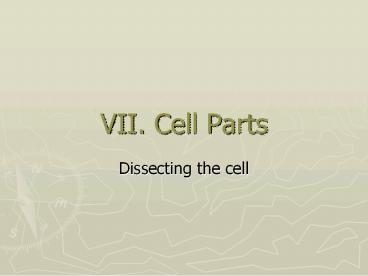VII. Cell Parts - PowerPoint PPT Presentation
1 / 23
Title:
VII. Cell Parts
Description:
VII. Cell Parts Dissecting the cell Quick Definitions Homeostasis is the process of maintaining the cell s environment. Selective permeability is the process where ... – PowerPoint PPT presentation
Number of Views:123
Avg rating:3.0/5.0
Title: VII. Cell Parts
1
VII. Cell Parts
- Dissecting the cell
2
Quick Definitions
- Homeostasis is the process of maintaining the
cells environment. - Selective permeability is the process where a
cell allows some molecules into the cell and not
others.
3
A. Plasma Membrane
- Cells must control the materials that enter and
leave. - The PM is the boundary between the cell and its
environment.
4
3. PM Structure
- PM is made of a phospholipid bilayer
- Two phospholipid layers
- Hydrophilic likes water
- Hydrophobic afraid of water
5
4. Transport across the PM
- Fluid Mosaic Model
- Transport Proteins
6
B. Cell Wall
- Structure Rigid layer on the outside of the
cell membrane - Think egg shell and membrane
- Function cell support and protection
- Only in plants!
7
C. Cytoplasm
- Structure Clear, jelly-like fluid that fills
the cell - Mostly water
- Function Allows molecules to be transported
through the cell
8
Control Centers
- The Nucleus, Ribosomes, and Centrioles
9
D. Nucleus
- Structure Two membrane layers
- Nuclear pores allow RNA to exit nucleus
- Nucleolus
- Creates ribosomes
- Function
- The nucleus contains
- the genetic material for
- the cell (called chromatin)
10
E. Ribosomes
- Structure very small organelles
- small dots
- Found
- in the cytoplasm
- on the ER
- Function makes proteins
11
F. Centrioles
- Structure Small barrel shaped
- organelles
- Made up of bunches of microtubules
- Function Involved in cell division
- Found only in animal cells
12
Assembly, Transport Storage
- Other organelles
13
F. Endoplasmic Reticulum
- Structure
- Rough ER
- Covered in
- ribosomes
- Smooth ER
- No ribosomes
- Function Where chemical reactions take place in
the cell.
14
G. Golgi Apparatus
- Structure Flattened pancake-like layers
- Uses Vesicles to move things
- Function Sorts, packages and sends the products
of the ER
15
H. Vacuoles
- Structure plastid
- Plant cells have one large vacuole while animal
cells have many smaller vacuoles - Function temporary storage of materials
16
I. Lysosomes
- Structure plastid
- Function contain digestive enzymes that break
apart cellular waste for re-use
17
Cellular Energy
- Chloroplasts and Mitochondria
18
I. Lysosomes
- Structure plastid
- Function contain digestive enzymes that break
apart cellular waste for re-use
19
K. Mitochondria
- Structure Double membrane
- Increased surface area
- for reactions
- Function Energy powerhouses for the cell
20
Support Locomotion
21
L. Cytoskeleton
- Interior network of support in cells
- Criss-crossed web of small support beams
- Microtubules
- Microfilaments
22
M. Locomotion
- Cilia
- Short hair-like projections that move in a
wave-like fashion - Flagella
- Long whip like tails
- Found only in unicellular organisms
23
Homework
- Organelle Summary Sheet
- Flashcards
























![[VII]. Regulation of Gene Expression Via Signal Transduction PowerPoint PPT Presentation](https://s3.amazonaws.com/images.powershow.com/4917995.th0.jpg?_=20131220041)






